From the ![]() Pizza Issue
Pizza Issue
The old adage, “Kill ‘em with kindness,” is all about how to handle your enemies. But at Pizza Loves Emily, a hospitality group with six restaurants varying in concept, kindness is not a weapon; it’s a foundational throughline of their businesses, and a way of life.
Fortunately for the pizza-loving masses, pies happen to come in all kinds, and patrons and fans of the original shop in Brooklyn’s Clinton Hill neighborhood, named simply Emily, found a different sort of New York pizza place. Emily specializes in New Haven-style pies, charred and thin and covered in tangy red sauce, buried under a blizzard of salty pecorino cheese. It’s not the kind people might imagine coming from New York City. It’s not the kind that automatically comes covered in mozzarella, and it may not even resemble the cartoonish images the word “pizza” conjures. It’s the kind that leaves your fingers blackened and your paradigm of New York pizza culture in question.
That spot was only their first foray into pizza that isn’t “New York-style.” The question that Matt Hyland, chef/co-founder at the Pizza Loves Emily Group, asks when we sit down a few feet from his wood-fired oven, peacefully dormant during the off-service daytime—“What is New York pizza?”—is one that comes up often for the city’s pizza lovers. Especially as we find “New York Pizza” restaurants all over the country and the world, it has become a ubiquitous catch-all term, and much of it is ubiquitously bad. “I don’t even know what that term means,” he continues. “There are so many styles of pizza here.”
At Emily, Emmy Squared, and the recently opened Violet, Matt and co-founder Emily Hyland highlight a number of pizza styles, all of which they attribute to regions outside the city (New Haven, Detroit and Rhode Island, respectively). Each is a distinctly different kind of pizza. But maybe that’s because each is coming from a different kind of restaurant group.
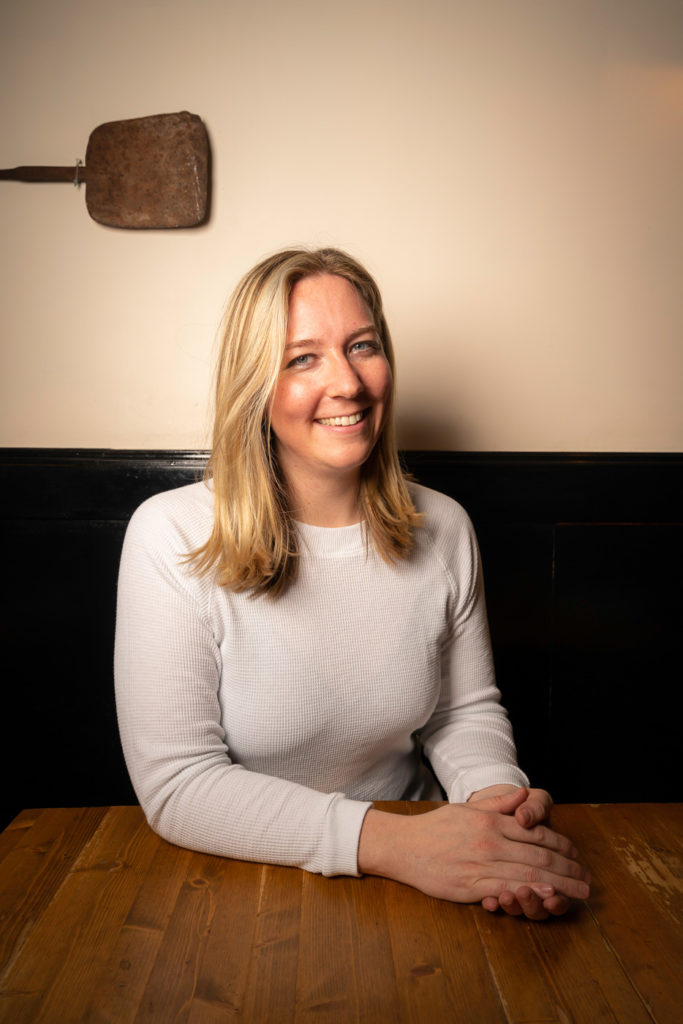
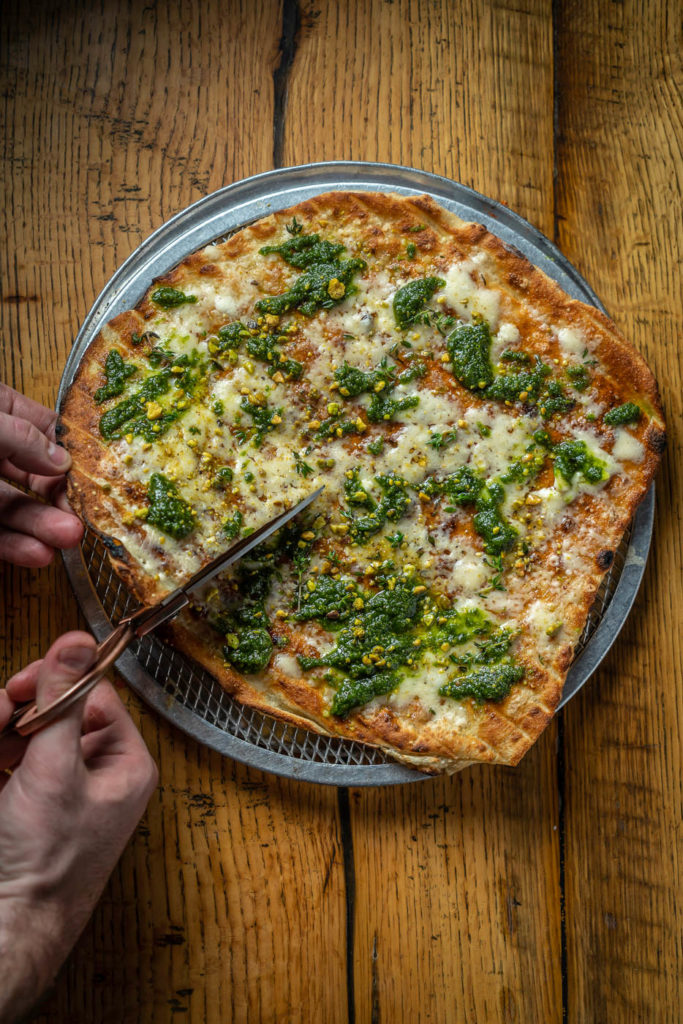

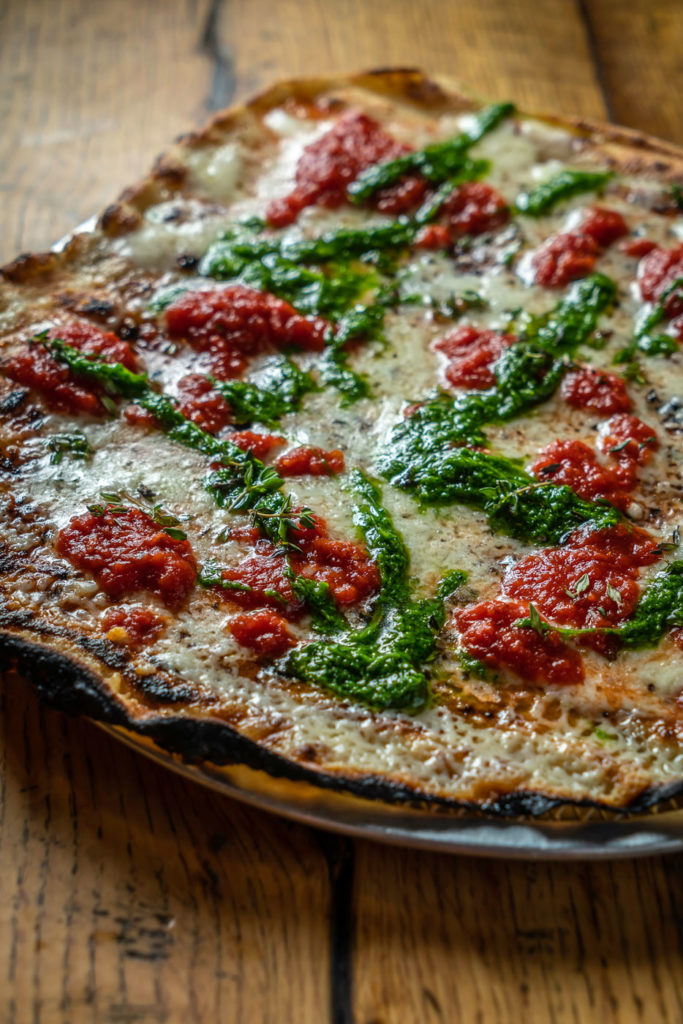
It’s the Kind of Food…
Matt and I quickly jump into conversation about being from Connecticut and the pizza culture there. While he grew up enjoying some of the same pies that graced my family’s table, Matt’s experience in the food business didn’t begin until after graduating college. It was then that he attended culinary school, and he was very intentional about how he would put that education to use.
Making pizza is a very specific discipline within an already specified industry, but as a chef, Matt was ready to take a deep dive. “I wanted to specialize in something,” he says. “I have a computer science degree as well,” he says, but there is a balance between the scientific and the romantic that appeals to Matt. “There’s something really beautiful about … cooking in a wood-fired oven. It’s so inconsistent, just trying to manipulate and figure out something completely wild and try to tame it.” He appreciated the challenge of constantly adjusting and recalibrating. “In a minute you can lose or gain one hundred degrees.” He refers to the variables that might be maddening to another cook (micromanaging temperature, humidity) as “a nice little puzzle”—one that was attractive to him.
Although there seems to have been plenty within that constantly evolving calibration to keep him from becoming complacent with pizza making, Matt sought to further diversify within the pizza canon. While Clinton Hill specializes in the wood-fired New Haven inspired round pies, the Emmy Squared offshoot is billed as “Detroit-style.” The fact that there are now three Emmy Squared locations—two in New York and one in Nashville, Tennessee (where Matt has a familial connection, and where the group’s strategic partners, Howard Greenstone and Ken Levitan are also associated with Nashville favorites like Adele’s and Bajos Sexto) speaks to the success of that particular interpretation.
“We wanted to do an homage to Detroit pizza,” Matt says. After obsessively tasting, observing and reverse engineering, they opened the second concept to a similarly enthusiastic audience, and it became clear the Emmy Squared Detroit-style pan pizza could be efficiently replicated as they considered growth. “The Detroit style is made in a convection oven so that’s a lot easier to bake, and thankfully people have been really receptive to it,” he says, whereas the training, implementation and control from a quality standpoint would be considerably more challenging with the wood-fired oven integral at Emily.
With their latest effort, Violet in the East Village, the group is again tapping into an underrepresented regional style of pizza, which they’ve tagged as Rhode Island since it draws inspiration from Providence institution Al Forno. And once again, a new kind of cooking technique was applied to the pizza: grilling.
There, a surprisingly chewy, pliable foundation of dough is grilled, the bassline upon which a melody of sauces like broccoli and pistachio pesto or hoisin, and the harmony of ingredients like duck prosciutto and clams, or spring onions and Sichuan oil can play out. A pair of kitchen shears is handed over, with which guests can go at it, cutting their own portions—or hell, setting them aside and folding the whole thing in half.
These pies are another example of Matt’s trial-and-error, study-and-observe style of culinary development. “I had been watching videos online,” he says of other grilled pizza makers, many of whom he tells me pre-bake their crust. Theirs, by contrast, is made to order. “The dough gets stretched out and goes right on the grill; there’s no stack of pre-grilled doughs,” he says. “We’re just going to try to find out the best way to do it for our kitchen and what makes sense for us.” What makes sense for them seems to be working, as Violet was recently awarded a coveted New York Times star by Pete Wells.
Matt has made a mission of mastering various pizzas, but Violet also expands into housemade pastas and grilled seafood, showcasing a wider breadth of New England inspired specialties. “[Matt’s] been slightly pigeonholed into this chef who makes pizza and burgers, when actually he’s this incredibly talented chef who has a lot more to offer,” Emily says.
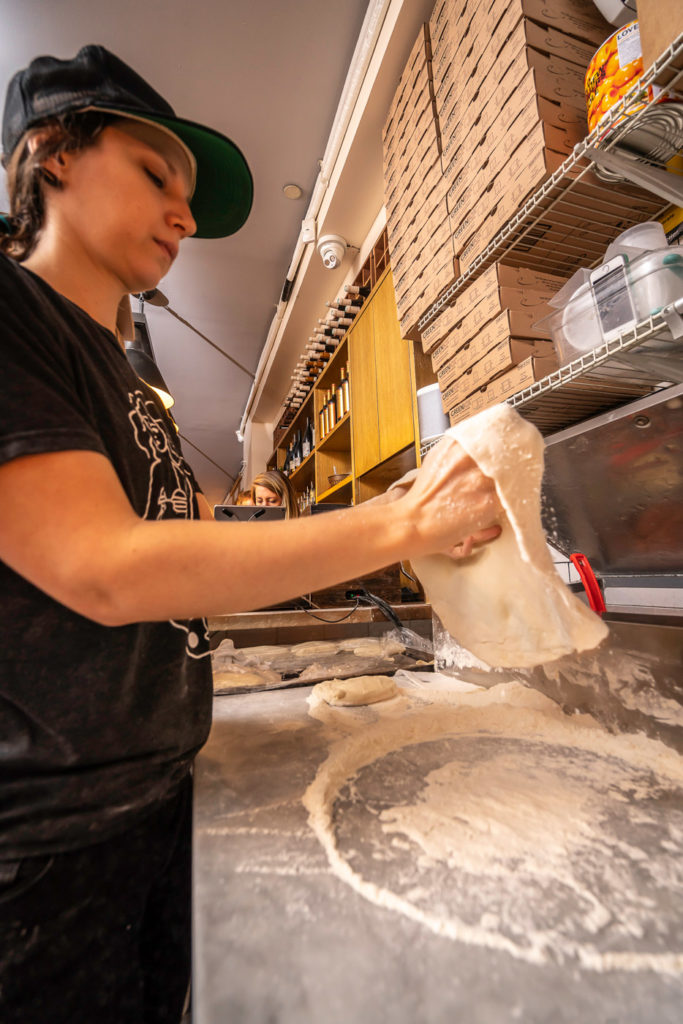
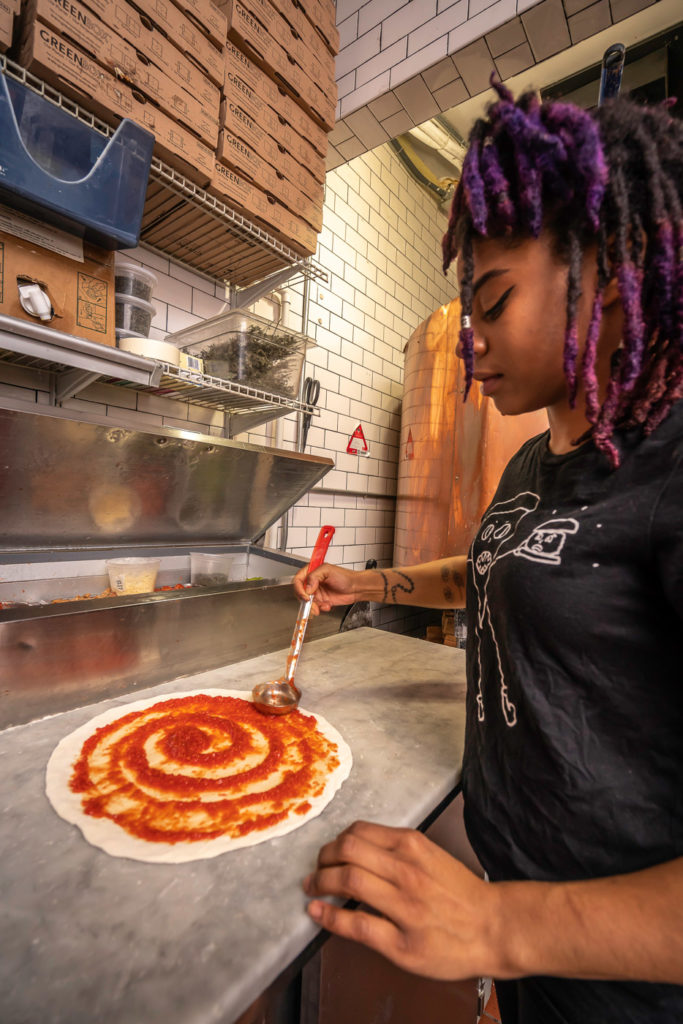
Their menus celebrate—and even maybe cement—regional identities, by paying homage to places that have inspired and been meaningful to them, and creating new memories for their guests. It’s pizza that may be made in New York, but is a tribute to the Naples-descended New Haven style, or to a city in Michigan, paying homage first in Brooklyn and then transporting to Tennessee. Or to a restaurant in Rhode Island, where they’ve shared their own impressionable meals over the years.
But in reality, regionality is secondary to quality, flavor and satisfaction, and Matt’s culinary choices may challenge expectations. Pizza restaurants are often known for Italian influence, but he tells me there are very few truly Italian ingredients in their kitchen.
Instead, American and even southeast Asian touches are more common in his toolbelt. “Adding fish sauce is always a great way to add umami; [it] can add a little saltiness and funk, but it doesn’t necessarily make it an Asian dish. Our vodka sauce is full of soy sauce and it just adds this body to it instead of adding meat to it, and we only use rice wine vinegar here,” he says. But the menu doesn’t always make a point of calling these items out; these ingredients are about function, not philosophy, per se.
But regardless of how it combines influences and ingredients, their food, their restaurants, and their personal philosophies unquestionably bring people together.
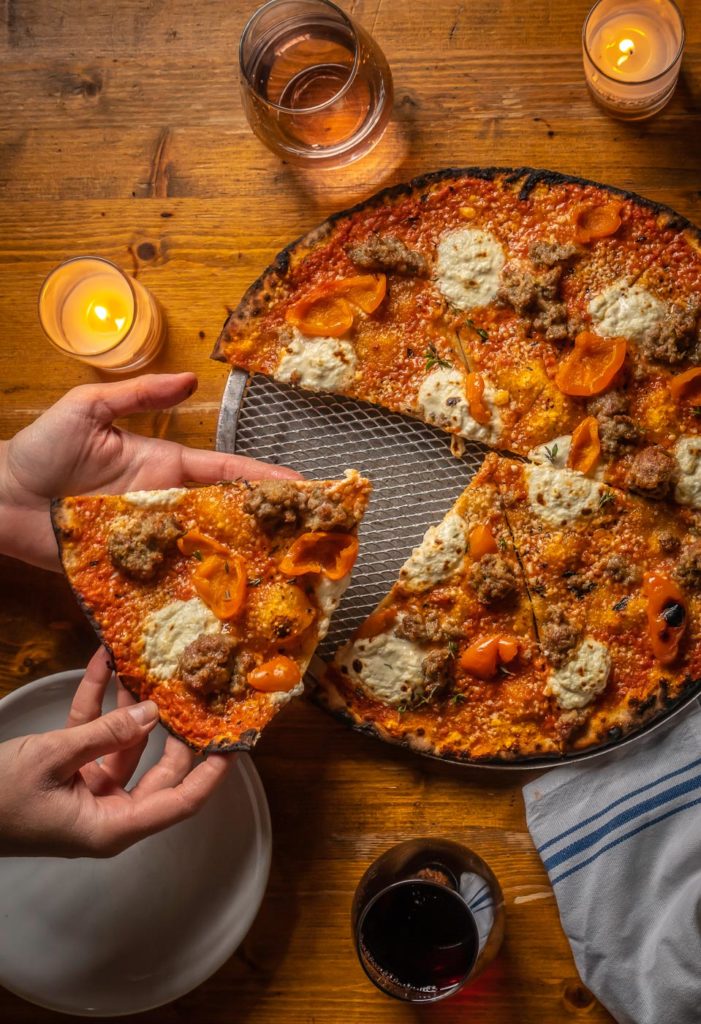
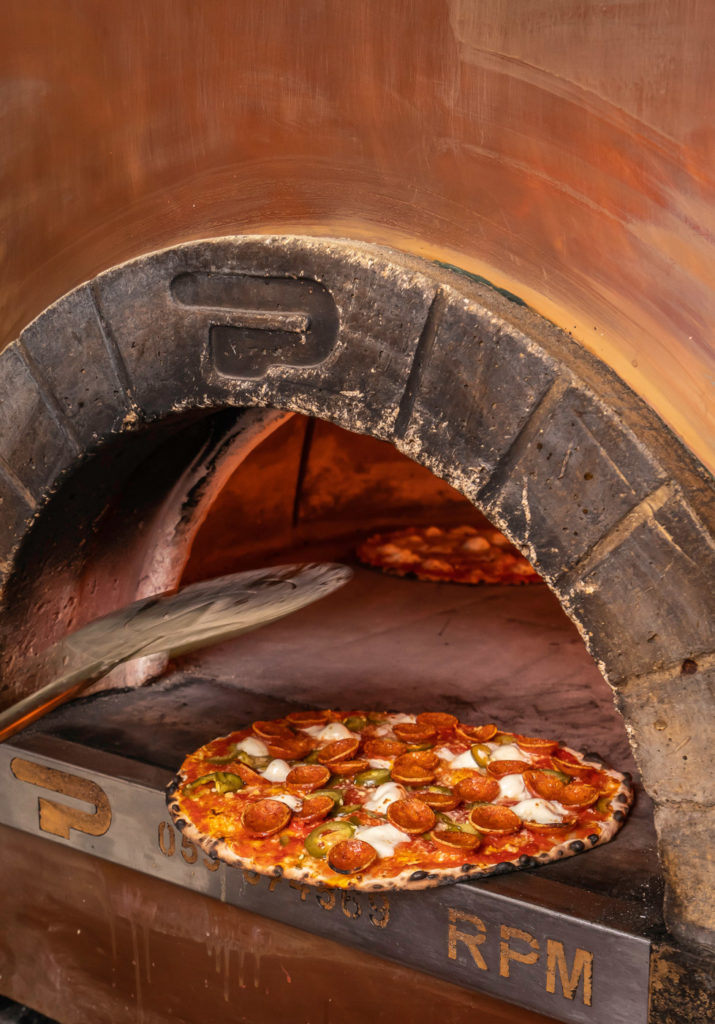
It’s the Kind of Culture…
When I meet with Emily separately, she and I fall into a similarly easy rapport. But we’re very quickly discussing a whole host of things that are not pizza. Yes, Emily confirms she still loves pizza as much as it evidently loves her. But she is the kind of entrepreneur who needs more to life than her business. In fact, operating the eponymous restaurant is only one facet of her professional world; she’s also a yoga instructor and a teacher of English composition at City College of Technology (part of CUNY) in Downtown Brooklyn. “It’s funny how life draws you down a certain path,” she says. She’s refilling my water glass like an old hospitality pro, but immediately prior to opening their first location, Emily was actually studying to become a school principal. “I have a lot of experience in systems-management and operational management in helping to found a public school,” she says.
Maybe they seem like disparate pursuits, but there is a common cornerstone in all Emily’s efforts, whether in the yoga studio, the classroom, or the dining room. “Community is big for me,” she says.
And as the namesake of the restaurant, she had good reason to be firm about its values. “That was a huge imperative for the core values and building culture—that it didn’t feel like a restaurant that was just a churn and burn of team members, or treated people poorly. It was meant to be a place of kindness and constructive feedback.”
The food world is notoriously male-dominated, the slice of it that is specific to pizza is even further female-deficient, and that’s a fact not lost on Emily. “It is a patriarchal world; that conditioning is strong and deeply rooted,” she says. She recalls scenarios that emphasized that sensibility. “Early on, I was distinctly struggling as a leader because Matt and I would sit down as owners—equals—to have a conversation where we needed to reprimand someone, and my tone would be just as even as his, and that person would identify me as a bitch and him as a boss.”
It’s not an uncommon sentiment among female leaders in any industry, but Emily believes femininity shouldn’t be a fault. “That general feminine sense of being sensitive is not something that’s accepted in the patriarchal structures of our society, let alone an industry like this where every word is terse,” she says. “My skin thickened and I’ve become less reactive, but that was definitely a challenge because it felt disingenuous, because that femininity felt so important to me.”
Today, she sees her position as an opportunity to help lift up fellow women in the food industry. “It’s been nice to bolster some of those women.” She tells me that of a four-person pizza team at Emily, two are women: Samantha Pathe and Chelsea Amber Ramos Mckensie.
Both Matt and Emily express a hope to provide an encouraging environment for their team. Matt and I discuss the culture being forged and fostered by two leaders who do not come from a long background in the food business, which he says is a simple one: “Don’t be an asshole,” he laughs. “Try to talk to people with respect. Of course, I can get frustrated; [it’s about] trying to check myself too and be a good role model, which doesn’t always work. But I try when possible.”
The pair’s academic, empathetic and pedagogic sensibilities extend to management style. Pathe, Emily’s Head Pizza Chef, describes the working environment with respect to its founders: “They’re both nurturing people.” And Ramos Mckensie, Pizza Chef at Emily, agrees: “Emily always asks me, how I’m doing, how I’m feeling, how things are running at the restaurant.”
Ramos Mckensie makes a note of comments she’s received from guests who are surprised to find a woman at the oven, and where the work can be especially demanding. “The wood-fire oven takes a lot of control,” she says, but gender aside, feels she’s been well-prepared for the role. “They trained me all the way from making dough to making sure you have the perfect char around the edge.”
Now, there is a clear coaching tree in bloom at PLE; since her own hiring, Pathe has subsequently trained Ramos Mckensie and others. “Usually in the food industry, if you don’t know much, they don’t really want you. I went in not knowing how to make pizzas and Sam is the one who trained me,” Ramos Mckensie says, explaining the significance of speed and efficiency in such a high pressure, high heat environment. “She taught me how to handle it,” she says of Pathe.
Building a culture that allows guests to enjoy well-made, intentional food and hospitality is as foundational as offering their team a supportive environment—especially in an industry notorious for intensity and pressure. Ramos Mckensie continues, “At Emily, we understand that and try to take that out. We are able to communicate with each other. And communication is key.” That communication, internal conscientiousness, and the idea that future opportunities exist are all part of the appeal for team members. “They’re growing really fast,” she continues. “Emily always tells me, ‘As we grow, you will grow as well.’”
Bolstered by the partnership with Greenstone and Levitan, both Matt and Emily have recently reclaimed some breathing room. “We have structure and more qualified people doing the roles they should be doing, and we’re not wearing a million hats,” Emily says, adding that it’s afforded her more time to instruct and practice yoga, and get back to the academic world as a teacher. “It’s allowed Matt to be able to create in this new culinary space of a new restaurant; he’d been spending a lot of time just on quality control and consistency,” she says of their expansion.
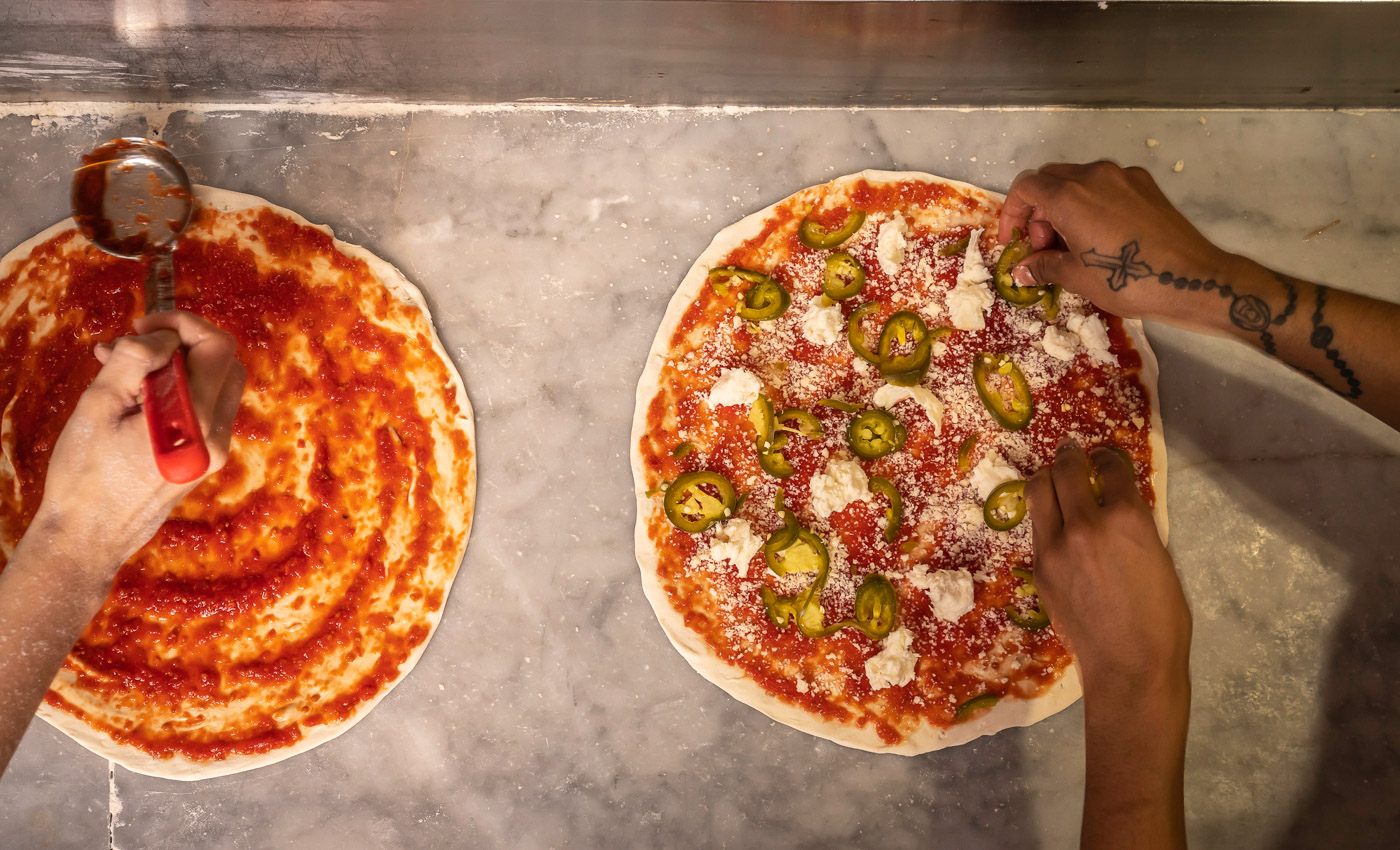
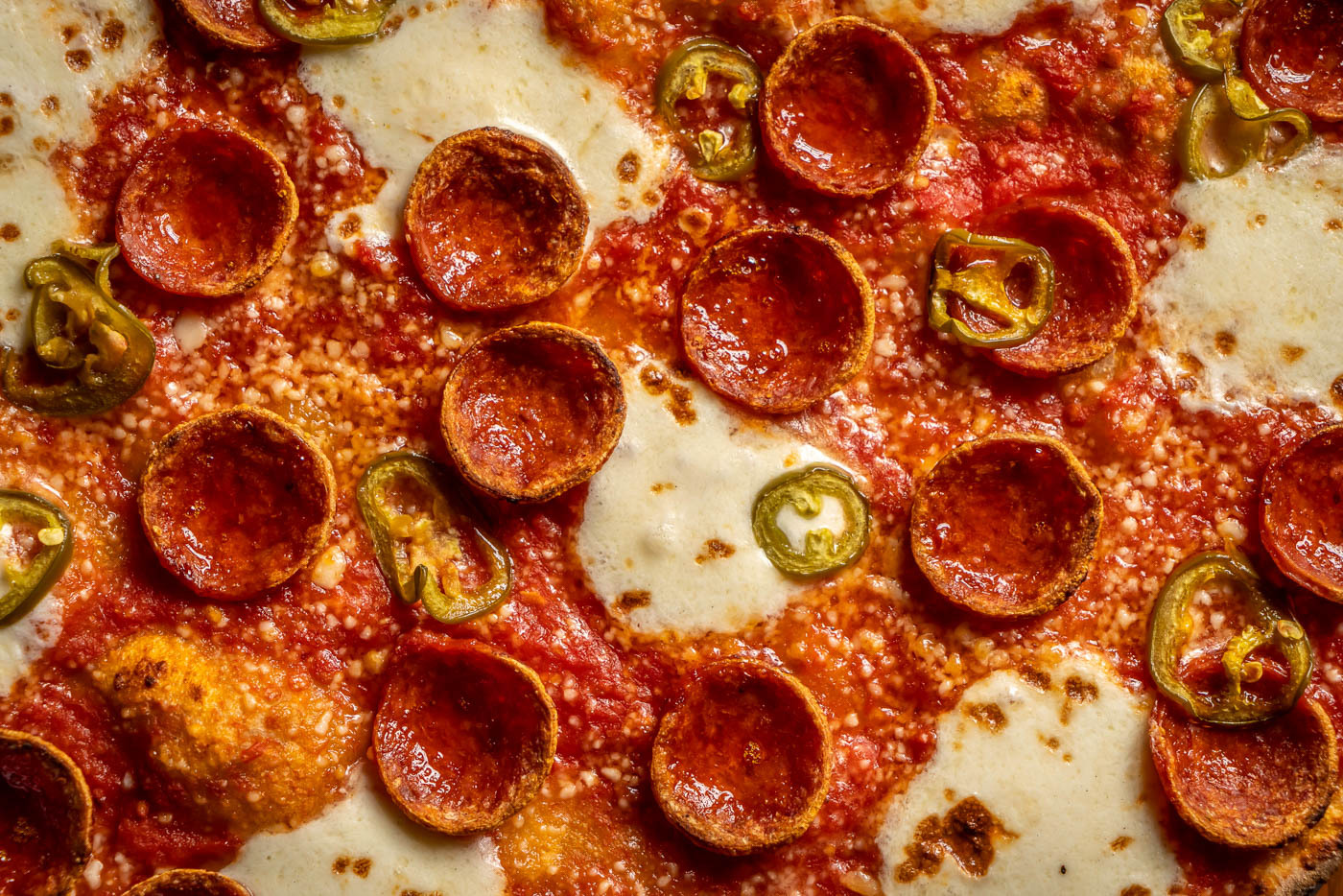
It’s the Kind of Community…
As PLE looks forward, the group is careful now to keep an eye on scalability, sustainability as a business, and growth opportunities both for the organization and its staff. Emily continues, “I feel blessed to have our strategic partners because they took this from a mom-and-pop with two nacient business people—two creative people who were just trying to make something happen—and turned it into a proper company; with that comes the systemization and ability to use people for the skills they really have.” The result is an ability to foster that growth, and look beyond the idea of what that mom-and-pop could be.
“Neither of us in our wildest dreams could ever have imagined what’s happened here,” she returns to the importance of the internal community of their restaurants, as well as the external. “One of the biggest contributors to that growth has been our neighborhood and the guests who are part of this family. We have pizzas named after children who’ve dined here, and locals who are now friends.”
Whether diners arrive from down the block, or make pizza night a proper destination experience, this is the kind of food that takes you back. “Pizza is really nostalgic,” Emily muses. “It is ingrained in our collective unconscious—those warm memories of sleepovers or pizza parties after basketball games or Friday night with the family, and I think that’s what makes it something that is accessible and really nice for everybody.”
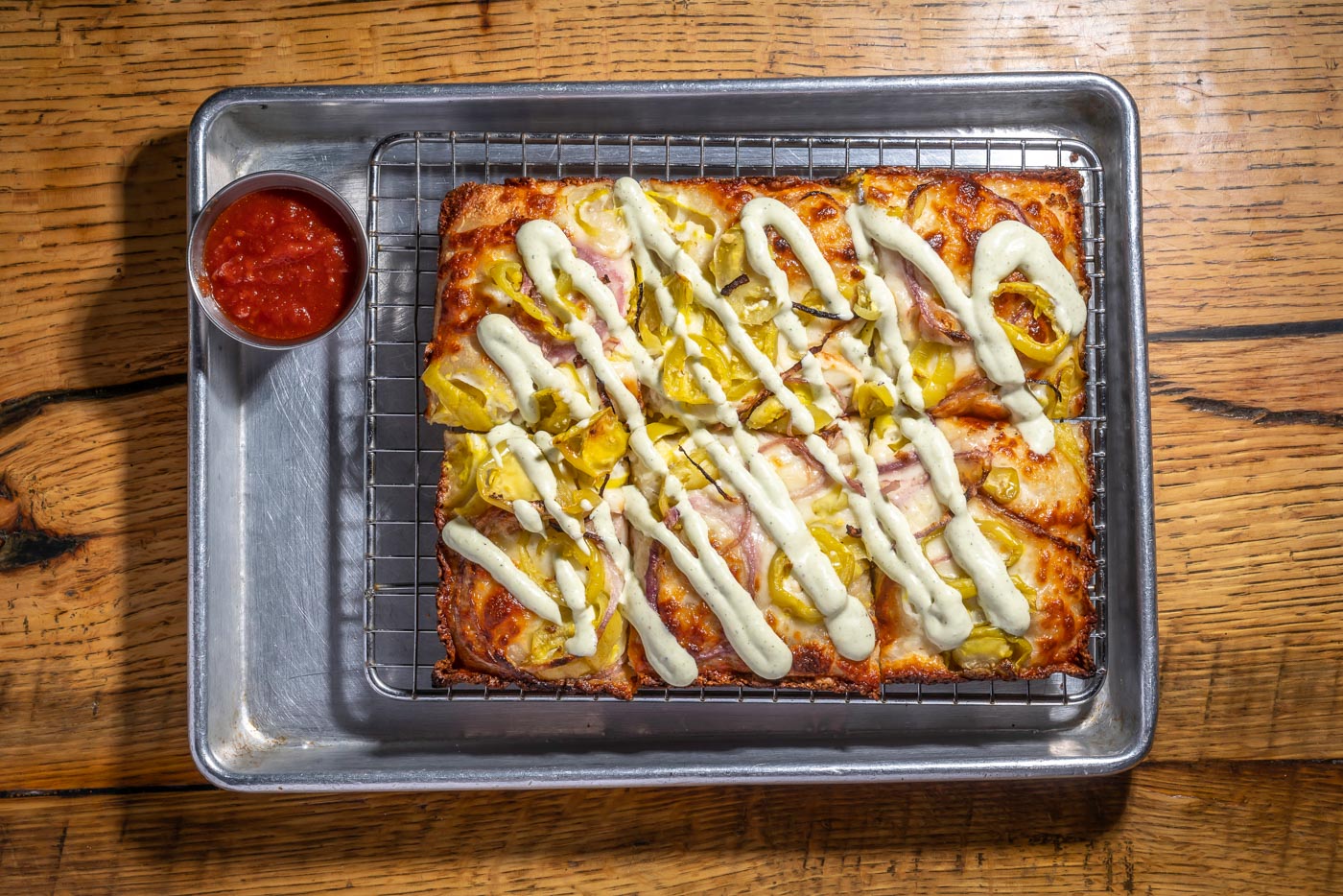
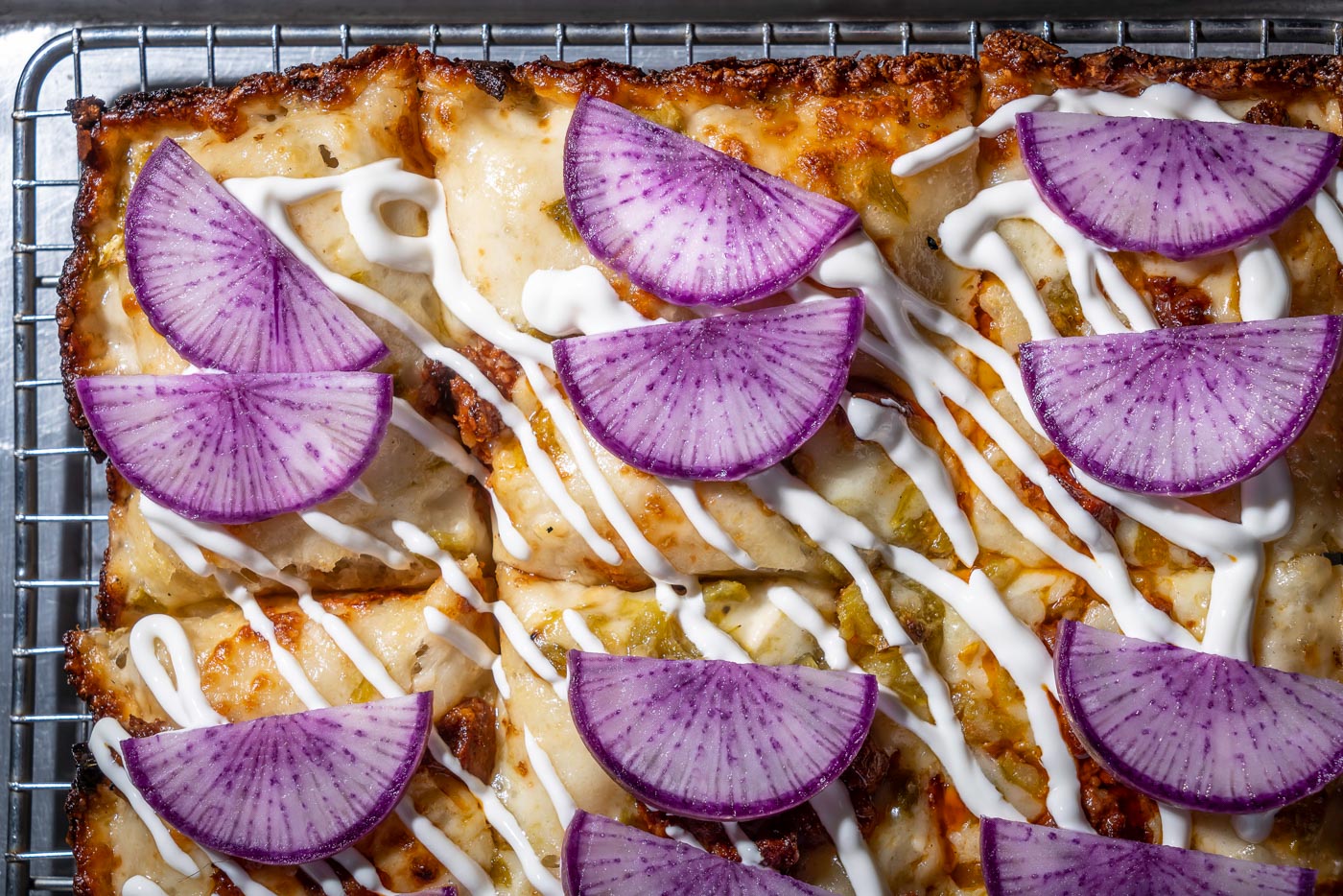

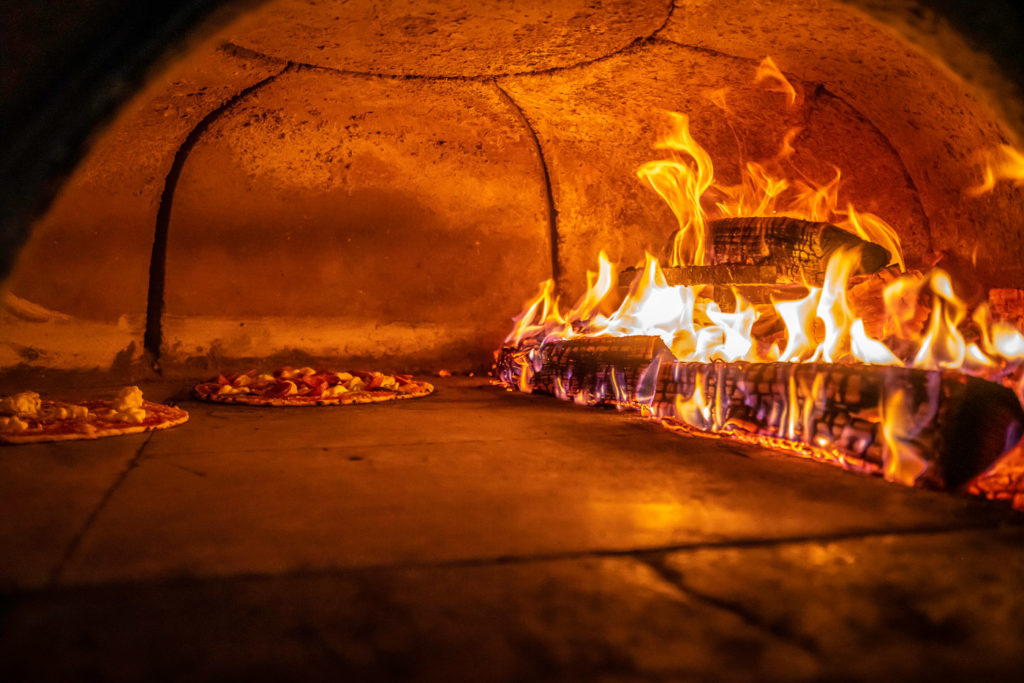
The fact that PLE has become known for those American classics is something that comes straight from Matt’s own history. “My cooking style is very personal,” he tells me. “It’s things I love from my childhood—take-out and Japanese and Chinese and Indian food and pizza; it’s what every person in the suburbs of New York grew up eating. My comfort food is not home cooking comfort food, it’s take-out food because that’s what I ate a lot of. I incorporate those flavors into my cooking because that’s what’s comforting to me.”
Turns out, comfort food commands attention. And while memories may be inspired by each meal, the staying power of a restaurant is attributed to more than food. “Kindness is the forefront of how I try to interact with community members and staff members,” Emily says. “What really makes [the restaurants] successful is not purporting that you’re invested in someone’s nice experience, but genuinely being interested and making that connection.” She explains to me that at their restaurants, there is a mantra: “Pizza is fun, and there’s no judgement. At the end of the day, it’s just dinner and it’s simple ingredients, so we just try to put forth quality food … that is really delicious and meant to be shared with a group of friends.”
And that is the kind of thing we can all appreciate, no matter where we’re coming from.







Our comments section is for members only.
Join today to gain exclusive access.